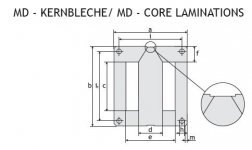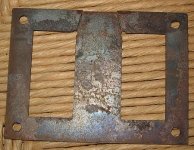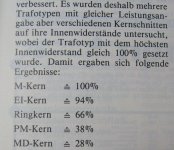I've seen it mentioned here:
Practical Transformer Winding
Practical Transformer Winding
Not all laminations follow the "economy" proportions, though. Here is an example of a lamination that comes in one piece, instead of being divided into an E and an I, and that has the windows proportionally much larger than the E-I lamination shown above. Such a lamination is a bit more expensive to make, because the steel cut from the windows is wasted, unless the manufacturer can find some other use for it. But being able to accomodate a much large winding assembly, it has some advantages in certain cases.
These "non-economy" laminations were quite usual in Europe, many years ago, but nowadays copper is so much more expensive than steel, that transformers are usually designed to use more steel and less copper. And for that goal, the economy lamination is very well suited. So you won't very often come across a lamination like this, unless you are restoring antique equipment.
Attachments
fama says equal or better specs than toroids, but expensive - cause not easily machinable
Hm Juergen, that is romantic nonsense.
Please see and read this (your own language).
Shouldn't be too difficult for Tommy to read too I hope.
Attachments
Last edited by a moderator:
hm pieter, what are you referring too? According to your document the MD cut outperforms the EI and M cuts. And I have an article lying around somewhere promising lower inner resistance even than toroids while having a comparable strayfield and size.
hm pieter, what are you referring too? According to your document the MD cut outperforms the EI and M cuts. And I have an article lying around somewhere promising lower inner resistance even than toroids while having a comparable strayfield and size.
Juergen,
I just took a quick look at that Waasner document, haven't read the whole story.
In my opinion with whatever EI, M or MD core type you will never reach the same level of power "economics" as is possible for toroids, because of the simple fact that with all stamped laminates the corn orientation is not everywhere "in line" with the magnetic field.
Only c-cores and r-cores can approach toroids in that respect.
Also strayfields with non-toroids will always be larger because part of the core is exposed to the outside world; only with toroids, where the coil surrounds the whole core, strayfields are small, especially when it is a low T design.
Toroids have their own drawbacks however.
I'd be interested in the article you have laying around somewhere.
Interesting, according to the Waasner document it is possible to get 60% more power using the MD cut for the same steel weight, compared to M or EI cut, due to better utilization of the grain orientation when using MD cut.
power is a function of temperature rise, did that document say what levels of temperature rise is the 60% comparable to?
This is an old style core lamination plate. The center tap is bended in order to insert it into the bobbin. What is the pros and cons of of this type/style of plate? Thanks
the obvious, there is just one gap compared to EI's 2......
power is a function of temperature rise, did that document say what levels of temperature rise is the 60% comparable to?
the document says "equal size and temperature rise"
the document says "equal size and temperature rise"
then that core must really be good........
it allows 'better' iron and higher fluxes than EI cuts. Besides the costly iron, fitting the laminations into the bobbin is more difficult so it never entered mass production. Otherwise MD cores probably would have been in real competition with toroids.
and some blurb on transformers at Jogis Röhrenbude:
Der Uebertrager, das unbekannte Wesen
Der Uebertrager, das unbekannte Wesen
Der erste große Vorteil ist, man kann genau die selben Spulenkörper verwenden wie beim M-Schnitt. Ein weiterer Vorteil ist, daß der Schnitt im Blech nicht in der magnetischen Hauptachse liegt sondern auf den weniger belasteten Seitenschenkeln. Das D steht für DIAGONAL so wie der Schnitt ausgeführt ist um das Stopfen des Kerns zu ermöglichen. Statt eines Luftspalts hat man hier nur einen Haarspalt.
Damit das Ergebnis optimal wird, wurden die Querschenkel um 50 % verbreitert, die Bleche nur in kornorientierter Form in der magnetischen Hauptachse sowie in dünner 0.35 mm starker Ausführung mit der bestmöglich Silizium-Eisen-Legierung eingesetzt. Damit bekommt man sehr streuarme und leistungsfähige Übertrager in kompakter Bauform. Wenn Netztrafos mit diesem Blechschnitt richtig berechnet und gewickelt werden, sind sie noch streuärmer als Ringkerntrafos.
Der einzige Nachteil der MD-Kerne ist, daß z.B. bei einem M 102 statt den Kernmaßen 102 mm x 102 mm beim MD 102 ein Kernmaß von 102 mm x 120 mm notwendig ist. Angesichts der vielen Vorteile können 18 mm mehr in einer Achse in Kauf genommen werden. Das Volumenmaß eines MD-Kerns ist auch nicht größer als ein Ringkern, denn auch hier gelten die physikalischen Regeln bezüglich des notwendigen Eisenquerschnitts und der notwendigen Windungszahl und der Drahtstärke.
Beim Ringkern hat man auch immer das Problem, was macht man mit den "runden Ecken"? Quadratische oder rechteckige Bauformen lassen sich immer bequem bei bester Raumausnutzung unterbringen. Und da bei richtig gerechneten Netztrafos mit MD-Kern die selbe Streuarmut wie bei Ringkernen erreicht werden kann, können diese problemlos eingesetzt werden.
it allows 'better' iron and higher fluxes than EI cuts. Besides the costly iron, fitting the laminations into the bobbin is more difficult so it never entered mass production. Otherwise MD cores probably would have been in real competition with toroids.
MD laminations are one example of a series of laminates which differ from the lossless EI in order to improve certain parameters.
For all these alternative laminations there must be a logical application, for example when weight matters.
Mostly however it seems more economic to use EI, because transformer manufacturers have equipment to assemble the laminates into cores with the required stacking height (sometimes even with a welding option), and then they only have to buy their bulk quantity of EI laminates.
I don't believe in competition between MD and toroid because winding a toroid is a completely different procedure; when toroids hit the market it was actually done with the alternative "better" laminates, and nowadays the world wide capacity of producing toroids is enormous.
Right now Waasner in Germany is one of the few remaining manufacturers of laminates in Europe; the bulk is coming from the East. Maybe Waasner could still supply the special laminates, but cost wise it would not be able to compete with toroids.
yes of course, toroids nowadays are cheap, but they weren't at the beginning. So in the past there may have been a window of opportunity for MD cuts gaining some market share.
Last edited:
Agree.
Toroids have a big market share nowadays, and not all toroids are an improvement over one of the more classic types.
It's a pity that the better laminate types did not make it because of this economy of scale.
For my transformers I use exclusively what is in my opinion the best compromise between laminate types and toroids, that is c-cores.
Toroids have a big market share nowadays, and not all toroids are an improvement over one of the more classic types.
It's a pity that the better laminate types did not make it because of this economy of scale.
For my transformers I use exclusively what is in my opinion the best compromise between laminate types and toroids, that is c-cores.
In the "old days" toroids did not have ANY airgap. They where not wound grain orientated strips like nowdays. They where stanced out "discs" of unorientated steel. In strict ac application they where fine. The problem with the nowdays used "wound strip" toroid cores is that do to the fact that they are wound they can have a small airgap with fairly big local fluctations. This often unevenly distributed airgap and not particular rigid airgap can be the source of a whole lot of mechanical and electromagnetical noise especially with the high flux that grainorientated steel allows us to use nowdays to minimize weigth and cost.
A core with 2 magnetic paths has advantages over a core with only 1 magnetic path because a split magnetic path has smaller inner to outer magnetic path length difference at the same core-width. This givs the MD-core a advantage compared to the toroid. Furthermore the MD-core "window" coppercontent is in a totally different leage no industrial wound toroid could ever compete with.
- Status
- Not open for further replies.
- Home
- Amplifiers
- Power Supplies
- Core lamination



